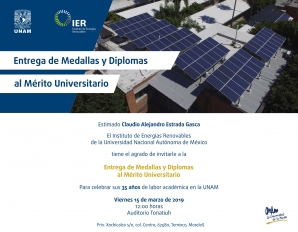Mostrando artículos por etiqueta: 2013 publication
Numerical study of the Boussinesq approach validity for natural convection and surface thermal radiation in an open cavity
M. Montiel Gonzalez, J. Hinojosa Palafox, C. Estrada Gasca.
Abstract
A comparison was made between six turbulence models and experimental temperature profiles for the turbulent natural convection in a tilted open cubic cavity. The experimental setup consists of a cubic cavity of 1 m by side with one vertical wall receiving a constant and uniform heat flux, whereas the remaining walls are thermally insulated. The thermal fluid is air and the aperture is facing the heated wall. The temperature profiles were obtained at different heights and depths and each one consists of 10 positions inside the cavity. A commercial computational fluid dynamic software was used for the simulation and different turbulence models of k-εt and k-ω families were evaluated against experimental data. The lowest absolute average percentage difference for the experimental and numerical temperature profiles was for the rk-εt model and the highest was for the sk-ω model.
Enhanced mineralization of atrazine by means of photodegradationprocesses using solar energy at pilot plant scale
Carlos Antonio Pineda Arellano, A. Jiménez González, Susana Silva Martínez, Iván Salgado-Tránsito, Cesar Pérez Franco
Abstract
Atrazine is a highly persistent and carcinogenic compound used as herbicide around the world. This compound has been banned in USA and some European countries but in Mexico it is still widely used in the agriculture. In order to achieve a high mineralization of atrazine, present as active compound in the Gesaprim commercial herbicide, detoxification studies in two-compound parabolic solar reactors by means of photo-Fenton process followed by TiO2 photocatalysis was carried out. The atrazine contents in the Gesaprim solutions tested were 35 mg L−1 (19.0 mg L−1 of TOC) and 20 mg L−1 (9.5 mg L−1 of TOC). [H2O2]0/COD0 ratios of 1, 3 and 5 (1.5 × 10−3, 4.5 × 10−3 and 7.5 × 10−3 mol L−1 H2O2, respectively) were evaluated in combination with 5 mg L−1 and 10 mg L−1 Fe2+ at pH 2.8 in the photo-Fenton oxidation; whereas, in the photocatalytic process, the influence of the pH (4.8, 7.0 and 11.0) and type of TiO2 (Degussa P25 and HB) were studied with TiO2 content of 200 mg L−1. The study showed that photo-Fenton process followed by TiO2 photocatalysis produce a 72% of mineralization (for an initial TOC of 19 mg L−1) and decrease above 90% of toxicity in compliance with NMX-AA-110-1995-SCFI1 Mexican Norm. In order to established a minimum amount of chemical reagents these photodegradation processes were carried out with special emphasis on the optimization of experimental parameters such as concentrations of photocatalyst and oxidant. Atrazine mineralization was influenced by the pH of the solution, the initial concentration of hydrogen peroxide and iron ions.
Transición energética, energías renovables y energía solar de potencia
C. A. Estrada Gasca
Abstract
En este trabajo se reflexiona sobre la problemática energética mundial; la finitud de las fuentes fósiles y su impacto al medio ambiente. La estructura energética mundial es no sustentable y se requiere de un cambio de paradigma energético basado en la eficiencia energética y el uso de fuentes alternas como las energéas renovables (ER). La demanda energética mundial está en continuo aumento a un ritmo de crecimiento anual del 2.47%. En un escenario al 2030 para la transformación del sistema mundial de energía, elaborado a partir del cumplimiento de nuevas políticas energéticas que consideran una economía baja en carbón para la protección del medio ambiente, todas las fuentes primarias contribuyen a satisfacer la demanda energética. De hecho, las fuentes primarias de energía que más crecen son el gas y las ER. En particular, la taza a la que las ER están creciendo y penetrando los mercados mundiales de la energía tiene una marcada similitud con la aparición de la energía nuclear en los años 1970’s y 1980’s.
México cuenta con abundantes recursos renovables y se han hecho esfuerzos importantes para avanzar en el uso de las tecnolog´ıas que aprovechan las fuentes de ER. El potencial solar del pa´ıs es realmente muy grande y el uso de las tecnologías solares que aprovechan dicho recurso es muy limitado. Se requiere, para garantizar el desarrollo sustentable en el país, que el estado mexicano se comprometa, con una visión a largo plazo, en el aprovechamiento de las ER y en el uso eficiente de la energ´ıa. Se deberán generar las políticas, los marcos legales, los incentivos económicos y los fondos de financiamiento para apoyar a la investigación científica y tecnológica y permitir el desarrollo masivo de las ER y del uso eficiente de la energ´ıa en el país.
Transicién energética, energéas renovables y energéa solar de potencia

